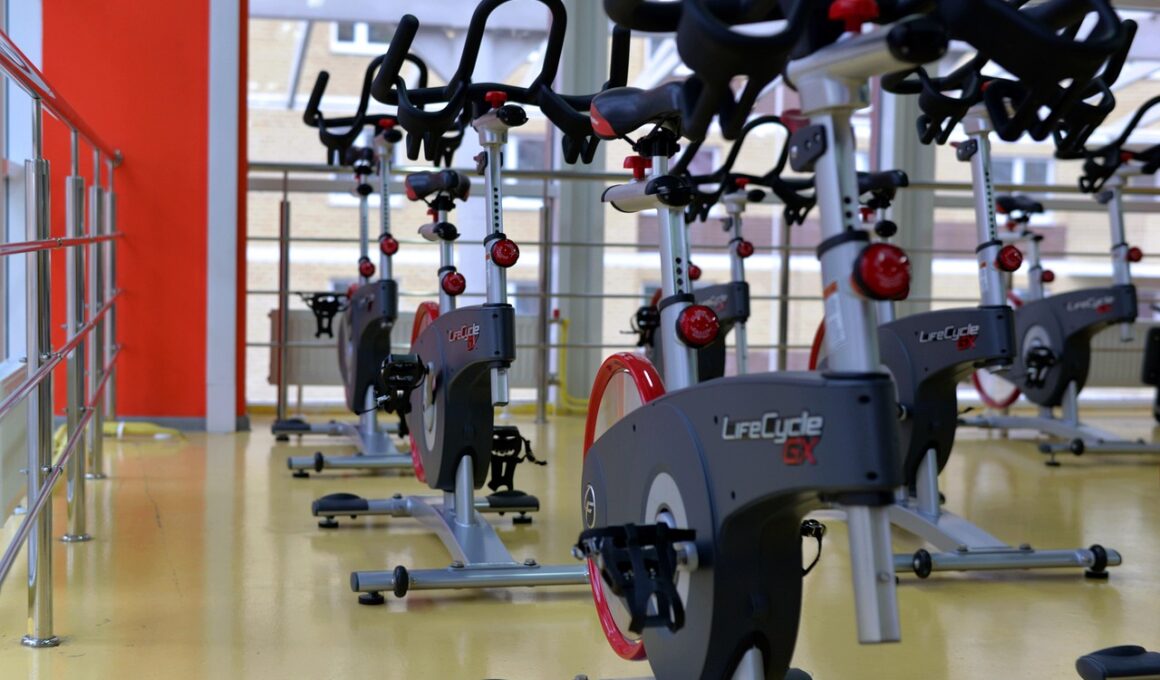How to Balance Indoor Cycling with Other Fitness Activities
Balancing indoor cycling with other fitness activities requires a strategic approach. Many enthusiasts often focus solely on cycling, thinking that it will suffice for their fitness needs. However, incorporating various workout types can enhance overall fitness and prevent monotony. Start by evaluating your fitness goals. Are you aiming for weight loss, improved muscular strength, or perhaps better cardiovascular health? Consider how much time you can dedicate to cycling versus other activities. An effective strategy includes alternating cycling sessions with strength training, yoga, or Pilates, which promotes flexibility. You might choose to cycle three times a week while dedicating two days to strength training and one to yoga. Additionally, pay attention to how your body responds to the varied training. Ensure sufficient recovery time and modify your routine accordingly. To stay motivated, consider joining classes that incorporate different activities, such as spin classes that include core workouts. These classes foster community and can offer new experiences, making workouts more enjoyable. Keep track of your progress to see how each activity complements your fitness goals, thus reinforcing your commitment to a balanced fitness regimen.
Another important factor in balancing indoor cycling with other fitness activities involves nutrition and hydration. Proper diet fuels your workouts, especially when you cycle several times a week. Focus on a balanced diet rich in whole grains, lean proteins, and healthy fats. These nutrients help restore energy levels and repair muscles after intense cycling sessions. Staying hydrated is equally crucial, as dehydration can significantly impact performance and recovery. Aim to drink water before, during, and after your workouts; consider electrolyte drinks for longer cycling sessions. Pay attention to how food choices influence your performance and energy levels. Many cyclists find timing their meals to be beneficial; eating a small snack of carbohydrates and protein about 30 minutes before cycling can improve performance. Post-workout meals should focus on recovery, ideally containing protein and carbs within an hour after cycling. Experiment with different meal timings and contents to find what works best for you, helping integrate cycling efficiently into a broader fitness regimen. Additionally, attending nutrition workshops or consulting with a dietitian can provide tailored advice to support your active lifestyle.
Incorporating Strength Training
Incorporating strength training alongside indoor cycling can significantly enhance overall performance. While cycling builds endurance and cardiovascular fitness, strength training develops muscle strength and stability. A well-defined strength training routine targeting major muscle groups complements cycling. Focus on exercises such as squats, lunges, deadlifts, and core strengthening moves. These workouts reduce the risk of injury by promoting muscle stability during cycling. Optimal strength training days should be spaced throughout the week, ideally on non-cycling days unless you prefer a combined session. Consider working with a fitness trainer who can help design a balanced program tailored to cycling goals. Performing strength exercises before or after cycling can create a comprehensive workout routine suitable for your schedule. Ensure proper technique and variations to maximize benefits. With progressive overload principles, aim to gradually increase weights over time for continuous improvement in both areas. Additionally, strength training aids recovery, allowing your body to adapt better while cycling. By embracing this balance, you will not only become a more efficient cyclist but also build overall body strength that will support all athletic endeavors.
Cross-training is another effective way to balance indoor cycling with various activities. Engaging in alternative workouts helps prevent overuse injuries while providing a break from routine cycling. Activities like swimming, rowing, or hiking can enhance your cardiovascular fitness and offer joint relief. Your body will benefit from these variations, allowing muscles to recover while still pushing your endurance level. You could incorporate cross-training sessions two to three times a week, alternating with cycling days. For instance, use swimming as a recovery day after a challenging cycling session, reducing the mental fatigue often associated with repetitive workouts. Cycling outdoors can also be a fantastic way to explore new terrains while challenging your body differently from indoor cycling. This summer, take your bike to trails or parks to experience nature while exercising. Keep an eye on your overall training volume; balance your schedule to maintain consistency without feeling overwhelmed. With thoughtful planning, cross-training can complement your indoor cycling endeavors, improving your overall fitness in diverse, enjoyable methods. Consider joining various classes or clubs that provide opportunities for cross-training, networking, and motivation.
Setting Realistic Goals
Setting realistic fitness goals remains crucial in balancing indoor cycling with other activities. By establishing clear, tangible objectives, you can maintain motivation and track progress effectively. Begin by defining what you wish to achieve from your fitness journey. It could be cycling a certain distance, losing weight, or mastering a new exercise. Ensure your goals follow the SMART criteria, meaning they should be Specific, Measurable, Achievable, Relevant, and Time-bound. For instance, you could aim to ride 100 miles within a month or complete a certain number of strength training sessions weekly. Break larger goals into smaller milestones to help celebrate progress along the way. Each milestone can motivate you throughout the process, preventing feelings of overwhelm. Don’t forget to reassess and adjust your goals over time, based on how your body feels and performs. Listen to your body and avoid pushing yourself too hard. Prioritize consistency over intensity; gradual changes in fitness levels will lead to lasting results. Share your goals with friends or in a fitness community to foster accountability, cheering each other on as you work toward balanced fitness success together.
Listening to your body plays a key role in achieving a successful balance between indoor cycling and various other fitness pursuits. Recognizing when to push through discomfort or take a rest day can profoundly impact long-term fitness. Indoor cycling may lead to muscle fatigue, which is essential to consider alongside other activities. Incorporate scheduled rest days into your routine to provide ample recovery time for muscle repair and growth. Always evaluate how well your body responds to various workouts, especially when introducing new ones like strength training or yoga. Consider keeping a workout journal that tracks how different activities affect your energy levels, mood, and performance. This practice will help identify which workouts leave you feeling invigorated versus exhausted, allowing you to adjust accordingly. Stay vigilant for signs of injury or extreme fatigue; both may be signals to reassess your fitness plan. Adequate sleep, hydration, and nutrition are integral to recovery, supporting peak performance levels during workouts. Balancing indoor cycling with other activities demands a mindful, body-centric approach to yield sustainable results while ensuring enjoyment and overall health remain a priority.
Finding Enjoyment
Finally, to effectively balance indoor cycling with other fitness activities, finding enjoyment in every workout remains essential. Engaging in exercises you love makes it more likely you will stick with your routine long-term. Experiment with different forms of cardio, strength workouts, or group classes to discover what resonates most with you. Having fun leads to ecstatic motivation; when workouts feel like a chore, compliance significantly diminishes. Consider joining local cycling clubs or fitness groups to connect with like-minded individuals. This networking can enhance motivation and create friendships built around a shared passion for fitness. Personalizing your cycling experience, such as creating the ultimate playlist or trying new training techniques, can also ramp up excitement. Track your progress, celebrate your achievements, and set new challenges regularly to keep things fresh and inspiring. Participation in events like “ride for a cause” or fun community races can offer additional motivation and boost your cycling experience. Finding joy in your fitness activities will perpetuate a healthier lifestyle that’s balanced, sustainable and ultimately leads to greater overall well-being. Make fitness fun and fulfilling, and the results will follow.
Now that you understand how to balance cycling with other activities. Embrace that enjoyment plays a big role in staying committed. You’ll likely find not only fitness improvements but also joy during every workout session if varied.


